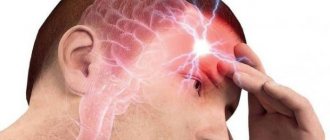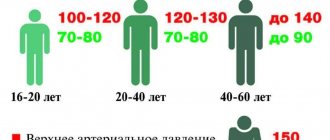Vegetovascular dystonia
VSD refers to disorders of the autonomic nervous system that cause a number of unpleasant symptoms. They are similar to the manifestations of other diseases and are quite vague, which is why many domestic doctors make this diagnosis in cases where they cannot or do not want to find the real problem. In this case, as a rule, there are no serious abnormalities in the body. For this reason, many doctors refuse to recognize this disease. Nevertheless, international medicine considers VSD a real disease and implies mandatory treatment.
Dystonia occurs in the presence of a hereditary predisposition, chronic stress and diseases of the nervous, cardiovascular, gastrointestinal or endocrine systems. Most often, it manifests itself against the backdrop of long-term experiences as follows: the human psyche tries to force an unpleasant situation out of the head, which is why neurotic symptoms appear throughout the body or in certain parts of it. The risk of VSD is increased in people who are often stressed, suffer from blood pressure problems, or have bad habits.
Dystonia comes in several types. The difference between them is which symptoms predominate. While in some cases high blood pressure is the most prominent problem in a person, in other patients heart pain is the most problematic. Such manifestations of the disease among patients lead to terrible thoughts that one can die from an attack of VSD.
Main types of VSD:
- hypertensive – characterized by high blood pressure, headache, a feeling of heaviness in the back of the head, darkening of the eyes and panic attacks;
- hypotonic – low blood pressure, general loss of strength, muscle weakness, irritability and apathy are observed, fainting is possible;
- cardiac – manifested by regular heart pain, tachycardia and arrhythmia occur, and regular sensations of lack of oxygen;
- mixed - a combination of symptoms of several types of dystonia is possible, often the whole spectrum of negative sensations manifests itself.
Vagotonic and cerebral types are also distinguished separately. In the first case, cardiac symptoms predominate, similar to serious heart disease. VSD can be chronic or manifest itself in the form of periodic crises and bright outbreaks. In the second case, VSD is characterized by impaired vascular tone in the brain, blurred vision, tachycardia and hot flashes.
When thinking about whether VSD is life-threatening, we must not forget that under the mask of dystonia there may be a serious illness that requires urgent treatment.
Dangerous symptoms of dystonia
Diagnosis of vegetative-vascular (another name is neurocirculatory) dystonia is often difficult due to the wide variety of symptoms described by the patient. For many, this is manifested by increased heart rate, sweating, chills, trembling limbs and chest pain. For some, it is accompanied by a headache, pressure surges, difficulty breathing or shortness of breath. Some feel nausea, sometimes to the point of vomiting, and sudden urges to urinate. All this is also classified as symptoms of autonomic disorder.
Often all these signs are united by a feeling of fear: from vague anxiety to a very distinct fear of death. This is especially true for a person whose dystonia is manifested mainly by cardiac symptoms: chest pain, tachycardia, dizziness, darkening of the eyes. Such patients, in addition to these sensations, clearly feel the fear of dying right during an attack. It is quite natural that they have a question about why VSD is dangerous and whether it leads to irreparable consequences.
In addition to fear, other emotional disorders also worsen. The patient feels increased fatigue, irritability, panic, and general instability of emotional reactions. Accumulated constant stress has an extremely negative impact on the quality of life, and in this aspect, the consequences of VSD can be considered dangerous for a person’s overall well-being.
Clinical manifestations
Dystonia manifests itself constantly with rare clearings or periodic attacks. At a time when the disease does not show itself, a person can often feel quite normal and have no health complaints. But the active phase of VSD will cause various symptoms. In some cases, it becomes very difficult to transfer them.
Manifestations of VSD:
- blood pressure disorders;
- fast or slow heart rate;
- shortness of breath, feeling of lack of oxygen;
- pain in the chest or heart;
- dizziness, headaches;
- heartburn, bloating, diarrhea, nausea;
- increased sweating, chills;
- numbness or tingling of the extremities, goosebumps;
- tinnitus, decreased visual acuity;
- worsening sleep, increased sleepiness during the day;
- irritability, apathy, neurosis;
- panic attacks, sudden fear of people;
- decreased attentiveness, deterioration of brain activity.
Such symptoms are very similar to a number of serious diseases. Therefore, before making a diagnosis, doctors have to prescribe a full examination to exclude other health disorders not related to the nervous system. Some people prefer to immediately diagnose VSD, bypassing all body checks. Such a decision can lead to serious consequences if the patient actually has diseases of a different kind.
Diagnosis of VSD
It can be difficult to determine vegetative-vascular dystonia, since the disease does not have any inherent symptoms. Children suffering from VSD have an unstable psyche and low weight, and examinations fail to detect any pathology. If VSD begins at a later age, then the main cause of the disease is damage to the nervous system, which leads to an imbalance in the functioning of the internal organs.
Symptoms of VSD depend on which organ system is affected. Why is it difficult to breathe with VSD? There are several reasons for shortness of breath or a feeling of insufficient air during breathing during VSD:
- hyperventilation of the lungs in the process of taking frequent and deep breaths, resulting in an excess of oxygen and a lack of carbon dioxide, which leads to depression of the respiratory center;
- outbreak of panic attack;
- exacerbation of respiratory diseases.
What happens in the respiratory form of VSD? The patient complains of lack of air. They are unable to take a deep breath in and out. Rapid breathing is observed, which is accompanied by excitement or fear.
In the cardiac form of VSD, patients are bothered by pain in the heart area, palpitations, and rhythm disturbances. There are sensations of “fading” of the heart, blood pressure increases or decreases.
The sexual form of vegetative-vascular disorder in men is manifested by anorgasmia - sexual desire is preserved, but orgasm is absent. In men, prostatitis develops, and in women, the menstrual cycle is disrupted and infertility occurs. This form of VSD is often accompanied by disorders of the urinary system - urination becomes more frequent, pain appears in the groin area and lower back.
With thermoregulatory VSD, there is an unreasonable increase in body temperature up to 37-38oC. The patient has cold extremities and reports hot flashes or chilliness. The dyspeptic form of VSD is manifested by the following symptoms:
- abdominal pain;
- nausea turning into vomiting;
- flatulence;
- constipation or diarrhea;
- dysfunction of the liver and gall bladder.
The following signs are characteristic of psychoneurological VSD:
- feeling of weakness, lethargy, fatigue;
- irritability;
- sleep disorders;
- decreased performance;
- headaches and dizziness with a feeling of unreality of the surrounding world;
- panic attacks;
- fainting;
- inability to navigate in an unfamiliar place.
How to determine? Doctors at the Yusupov Hospital begin diagnosing vegetative-vascular dystonia with a survey and clinical examination of the patient. Patients are consulted by a psychoneurologist and a neurologist. Depending on which system dysfunction predominates, related specialists are involved in the examination: gynecologist, cardiologist, andrologist.
To exclude the organic nature of the symptoms of the disease, the following studies are prescribed:
- determining the level and relationship of hormones;
- computed tomography;
- electroencephalography;
- ultrasonography.
Only then is treatment prescribed. Its goal is to eliminate the cause and symptoms of VSD.
Dangerous consequences of VSD
The autonomic nervous system is responsible for many functions of the body and provides it with the ability to adapt to the external environment. With dystonia, all this begins to malfunction. The most problematic are long-term manifestations of the disease, which are often accompanied by feelings of anxiety. To understand whether vegetative-vascular dystonia is dangerous for human life, it is enough to understand the disorders that arise when it appears.
Dangerous manifestations of VSD:
- heart problems;
- breathing problems;
- disruptions in the endocrine system;
- depression, psychosis, panic attacks.
Such manifestations carry a certain danger. Even if there is no harm from their direct influence, there is no guarantee that the patient will not suffer from the consequences. For example, he may faint and injure his head. Another disease may also develop against the background of constantly high or low blood pressure.
Panic attacks in children are considered the most harmful manifestation of dystonia. A teenager has a very flexible psyche, which is why he may not even be aware of what is happening. In such situations, the child is capable of doing something dangerous without realizing it. At the same time, all the main symptoms in children often manifest themselves more clearly, creating more problems for leading a normal life.
If the dangers for ordinary people are rather arbitrary and may not arise at all for many years, then for pregnant women they are quite real. Pregnancy requires utmost care and maintenance of the mother's health. With minimal deviations there is a risk of serious harm to the fetus. Therefore, various complications are possible with dystonia.
Why is VSD dangerous for pregnant women?
- premature birth;
- increased toxicosis, gestosis;
- bleeding during childbirth;
- anomalies of labor;
- intrauterine fetal hypoxia;
- suture dehiscence after childbirth;
- lactostasis.
Such violations can result in serious consequences. In most cases, everything goes well, and minor deviations can be quickly treated. But sometimes problems with the child’s development may still arise, which will require special attention from doctors. Therefore, when planning pregnancy, you should definitely take into account the fact that the mother has vegetative-vascular dystonia and report this to your doctor. You also need to remember that some usual medications for the symptoms of VSD may be strictly prohibited during the period of bearing a child.
Fear of death with VSD
There is a way to minimize the symptoms of VSD, reduce the number and intensity of panic attacks, reduce other manifestations characteristic of vegetative-vascular dystonia, for this you just need to overcome such a symptom of VSD as the fear of death. But it’s one thing to say - just get rid of the fear of death and everything will pass. Achieving this is much more difficult than it seems at first glance.
What is the fear of death with VSD
We all know that we will die someday. This is a fact, an inevitability. But in people suffering from VSD, fears for life manifest themselves in a strong exaggerated form, sometimes reaching the point of absurdity. And they can't do anything about it, it's stronger than them. And it is the fear of death that becomes the cause of panic attacks and manifestations of other aspects of the disease.
One has only to tingle a little in the right area of the abdomen and suddenly feel dizzy, and the patient perceives these symptoms as harbingers of imminent death. This fear can also manifest itself in the inability, for example, to eat foods that have been canned. The mere thought that you can, after eating a couple of pickled cucumbers, become infected with botulism and die in agony, terrifies patients with VSD.
On the one hand, they objectively understand that all this is nonsense from the realm of fantasy, but the other half awakens their imagination and opens their eyes to pictures, one more terrible than the other, provoking panic and further aggravating the fear of dying from any little thing.
Is there a way to get rid of panic before death and finally start living a normal, full life? This issue needs to be looked into in more detail.
Overcoming the fear of death
It’s worth sitting down and thinking about it - every second someone dies, no one is immune from this, a car might hit you, an ambulance might simply not make it in time because of a traffic jam. No one can influence the coming of death. Therefore, you just need to learn to relax and accept your state as something natural. It is worth remembering that the fear of dying is worse than death itself. There is no need to be afraid to live, then everything will return to normal.
Ways to free yourself from the fear of death
The main thing is to admit to yourself your fears and not be afraid to look like a coward in your own eyes or the eyes of others. This is part of you, you are afraid to die and this is a given that you need to come to terms with. The main thing now is to learn to live with it, and to make sure that this condition, which frightens and hinders a decent existence, does not interfere with ordinary current affairs.
Below are several ways to accept yourself; to some they may seem awkward and even not serious, but this is not the main thing, the important thing is that they help.
- Accept your fear and say it out loud. Yes, I'm afraid, and there's nothing criminal about it. Stop fighting the fear of death, and then it will recede; the stronger the fight, the more obvious its benefits.
- If the fear of death causes you to tremble, then do not fight it, but tremble, and even more than usual. It can even be enjoyable if you let go and let the trembling consume you.
- If the VSD becomes intense, do not resist. It’s just that your body tells you that it’s time to get some rest.
- Let love and care settle in your heart, when you love someone deeply and completely, fear has no place in your soul.
- Abstract from everything and imagine that you only have a few hours left to live. Is it really the ultimate dream to spend the last minutes of your life shaking with fear and sweating like this? Surely not. As soon as you imagine this, you will feel a surge of vitality and energy.
- A great way is to write down your fears on paper. Take a sheet of paper, divide it in half and in one column indicate all your phobias, and in the other write what you dream about, what you like to do, your plans for the future, even the smallest ones, for example, getting a pedicure. By comparing both columns, you will see that there is much more good in your life than bad. Are you really going to allow phobias to leave your dreams and plans unfulfilled?
Author: K.M.N., Academician of the Russian Academy of Medical Sciences M.A. Bobyr








